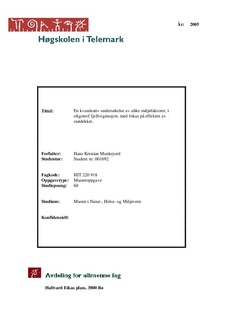| dc.description.abstract | The approach to the problem presented in this research study has been to investigate the response of alpine plants to varying depths of snow-covering and duration of the snow cover as well as point out different environmental gradients in oligotrof alpine vegetation. The research was carried out in the Kjelatind area, just south of Haukeliseter, in the Vest-Telemark County of Norway. The investigation area is situated in the slightly oceanic section (O1) and includes vegetation zones ranging from northern boreal to middle alpine. In the normal period (1961-1990) Haukeliseter snow-clearance station had an annual precipitation of 840 mm and an average annual temperature of 0.4ºC. The predominant wind direction is west-east and the investigation area lies on the watershed between West-Norway and East-Norway. The sampling was stratified to cover most types of oligotrof vegetation in the investigation area. The permanent quadrates also covered the gradient from ridge to late snow patch over different expositions, slopes and heights. Totally, 82 samples were investigated, each covering a total area of 4 square metres. The data material was analysed by use of numerical methods (DCA, CCA, GLM). The program package CANOCO and CANODRAW was used to carry out this analysis. Snow- and soil-temperature data was collected weekly from 27 March – 17 June 2004. Based on these data, snow melting- and soil temperature-graphs were created to interpolate which days the quadrates were free of snow (S=0) and which days the soil temperatures exceeded 6ºC (T>6). Within the 82 quadrates, 90 different vascular plants, 60 bryophytes (mosstaxa) and 21 lichens (lichentaxa) were found. The pattern in the snow melting- and soil temperature-graphs was distinctly correlated with temperature- and precipitation-data from the two nearby climate stations Midtlæger and Vågsli. Compared with the normal of 1961-1990 the snow melting started three weeks anterior in the low alpine zone, while it was equal to normal in the middle alpine zone. Early snow-bare ridges showed a slow increase in soil temperature, while quadrates lying sheltered or patched with snow had a rapid increase of soil temperature. In some cases, the soil temperatures of the snow patches were measured to over 6°C only a few cm from the edge of the snow. Ridges with a thin snow cover and a higher likelihood of ground frost were, still, significantly earlier free of snow (S=0, p=0.005) and reached a soil temperature higher than 6°C (T>6, p=0.0262) before the snow patched ground that had been protected by its cover of snow. The species-dataset was divided into 5 main groups using the TWINSPAN data program. DCA axis no. 1 was correlated with a complex snow-gradient, while DCA axis no. 2 was correlated to the complex gradient altitude level. The sample-scores’ frequencydistribution (i.e. number of species) was slightly discontinuous along DCA axis no. 1, while the samples were more continuously distributed along DCA axis no. 2. Of the 15 environmental variables used in the statistical analyses, as many as 14 were significant (p<0.05) according to the Monte Carlo Permutation test. The 15 environmental variables had an explanatory value of 35% of the variation of the data set. By the use of the GLM together with attribute plots, indicator values for snow were proposed based on the species’ response to the environmental variable S=0. Unmodal species were divided based on "the optimum snow free day", while species with a linear response were divided on the basis of the regression coefficient β0 and β1. An indicator value 1 (F1), F2, F8 and F9 was given to species with a linear response to S=0. Species with F1 did not occur in this investigation, F2 had a β0<40 and a β1<-25, F8 had β0>-100 and a β1<70, and F9 had a β0<-100 and a β1>70. The unmodal species were given values F3, F4, F5, F6 and F7, and were divided on the basis of "the optimum snow free day": F3 ≤ day 110 < F4 ≤ day 126 < F5 ≤ day 140 < F6 ≤ day 159 < F7. The "day" which divides the indicator values F3-F7 is relative, because the basis for distinguishing that "day" is the snow-melting pattern of the spring 2004. Maximum snow depth (Smaks) was the variable of the GLM which gave the most significant (p<0.05) species of all three snow variables: Smaks, S=0 and T>6. pH seems to be a good indicator for the complex snow-gradient, for oligotrophic vegetation types, because this variable had the highest correlation to the DCA axis no. 1 (r=0.83, p<0.001) as well as to the snow variables S=0 (r=0.74, p<0.001) and Smaks (r=0.70, p<0.001) | |
